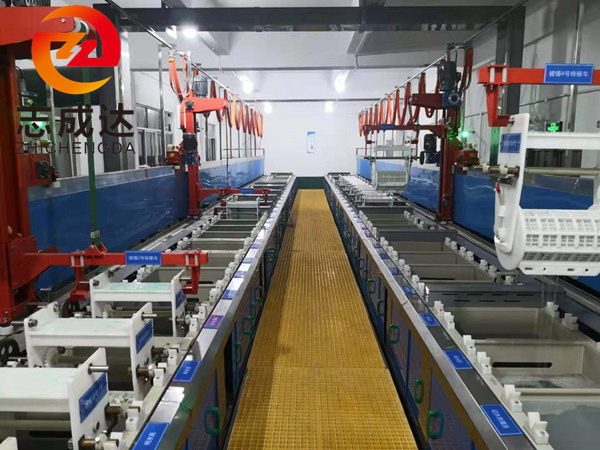- Selection of electrolytic conditions
The purpose of electrolysis here is to remove impurities from the plating solution. However, while removing impurities by electrolysis, it is often accompanied by discharge deposition of the main metal ions in the solution. In order to increase the rate of impurity removal and slow down the deposition rate of the main metal ions in the solution, attention should be paid to the operating conditions of the electrolytic treatment.
① Current density: During electrolytic treatment, it is better to control the current density. In principle, it should be in accordance with the current density range where impurities have adverse effects during electroplating. That is to say, during the electroplating process, if the influence of impurities is reflected in the low current density area, then the electrolytic treatment should be controlled at a low current density. If the influence of impurities is reflected in the high current density area, high current density should be used for electrolysis; if impurities have an impact in both the high current density area and the low current density area, then high current density electrolysis can be used for a period of time, and then low current density electrolysis can be used until the plating solution returns to normal. Under normal circumstances, all impurities that can be removed by low current density electrolysis are generally electrolyzed at low current density in order to reduce the deposition of the main discharge metal ions in the plating solution. In fact, in electroplating production, the influence of most impurities is reflected in the low current density area, so the current density of electrolytic treatment is usually controlled between 0.1A/dm2 and 0.5A/dm2.
② Temperature and pH value: In principle, the selection of temperature and pH value during electrolytic treatment should also be based on the temperature and pH range where impurities have a greater adverse effect during electroplating. For example, copper impurities and NO3- impurities in nickel plating solution have a greater impact when the pH is low, so when electrolytically removing copper impurities and NO3- impurities in nickel plating solution, low pH should be used for electrolysis. Under such conditions, the rate of impurity removal is faster. Some impurities will decompose into gas during the electrolysis process (such as NO3- reduced to nitrogen oxides or ammonia at the cathode, Cl- oxidized to Cl2 at the anode, etc.). At this time, high-temperature electrolysis should be used to volatilize the gas formed during the electrolysis process (the solubility of gas in the solution generally decreases with increasing temperature), thereby preventing it from dissolving in water and re-contaminating the plating solution.
According to general rules, as the temperature of the plating solution increases, the rate of electrolytic removal of impurities also increases. Therefore, when heating has no effect on the main components of the plating solution, the electrolytic treatment should be carried out under heating. However, it is best to determine at what temperature through small experiments.
③ Stirring: Since the electrolytic treatment relies on the reaction of impurities on the surface of the cathode (or anode) to be removed, conditions should be created to allow the impurities to have sufficient contact opportunities with the electrode surface. Stirring can accelerate the movement of impurities and increase their contact opportunities with the electrode. Therefore, in order to improve the treatment effect, the plating solution should be stirred during electrolysis.
- Requirements for electrolytic treatment
① First, find out whether harmful impurities come from the electrolytic process: electrolytic treatment can remove certain impurities, but sometimes impurities will also be produced. For example, if harmful impurities come from impure anodes, and such anodes are still used during electrolytic treatment, then as the electrolytic process proceeds, impurities will accumulate more and more; if impurities come from the decomposition of certain compounds on the electrode, then electrolysis will gradually increase such decomposition products. Such electrolytic treatment not only fails to purify the plating solution, but will continue to aggravate the pollution of the plating solution. Therefore, before electrolytic treatment, necessary inspections should be carried out to prevent the generation of harmful impurities during the treatment process.
The area of the cathode (false cathode) used for electrolysis should be as large as possible: the removal of impurities by electrolysis is mostly carried out on the cathode surface, so increasing the cathode area can improve the efficiency of impurity removal. At the same time, in order to electrolytically remove different impurities or the same impurities in the plating solution at different current density locations, the cathode used for electrolysis is required to be made into a concave and convex surface (such as corrugated shape), which can improve the effect of electrolytic treatment. However, the concave part on the cathode should not be too deep to prevent the current density from being too small so that impurities cannot be deposited or reduced in these parts.
③ During the electrolysis process, the cathode should be cleaned regularly: Since the electrolysis treatment time is generally long, loose deposits may be produced on the cathode during the long electrolysis process, and its shedding will re-contaminate the plating solution. Therefore, after a period of electrolysis, the cathode should be removed and cleaned, and the loose or poor deposits on the cathode should be brushed off before continuing the electrolysis.
④ Before the electrolysis treatment, it is best to do a small test to estimate the effect and time of the electrolysis treatment: Some impurities are difficult to remove by electrolysis. If electrolysis is used blindly, it may take a long time to restore the plating solution to normal.

